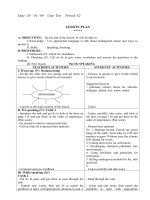Unit 10 - (Speaking)
Bạn đang xem bản rút gọn của tài liệu. Xem và tải ngay bản đầy đủ của tài liệu tại đây (151.99 KB, 4 trang )
Lesson Plan 12 – Ham Thuan Bac High School
UNIT 10 ENDANGERED SPECIES
Period 61 SPEAKING
A. Aims: Help students ask and answer some questions about endangered animals and talk about the
information of some endangered animals
1. Knowledge:
- General knowledge: Endangered animals
- Language: + The way to make suggestions or predictions
+ The tenses.
- New words: words related to endangered species.
2. Skills:
- Improve students’ speaking skill
- Talking about the information of some endangered animals
B. Methods: Words of subject and activity
Communicative approach
C. Teaching aids : Textbook, posters, pictures, ….
D. Procedures:
TEACHER’S ACTIVITIES STUDENTS’ ACTIVITIES
I. WARM – UP ( 5min.)
- Ask Ss to discuss the questions.
1. What is the most famous animal in China?
2. What kind of animal can be called "King of the
beasts"?
3. Which animal has a long trunk?
……………..
→ Introduces the new lesson.
"In today’s speaking section, you will practice
Talking about life and habitat of some animals"
II. PRESENTATION ( 35 min.)
1. Pre-speaking:
- Ask Ss to study the requirements in tasks then find
out the new words
- Help Ss with the vocabulary and pronunciation
- Elicit some useful expressions:
→ Checking ROR: Match column A with B:
Column A
A: ________(1)_________
B: In bamboo forest in the mountains in central and
western China.
A: ________(2)_________
B: Only about 600
A: ________(3)_________
B: From 75 to 160kg
A: ________(4)_________
B: Bamboo
A: ________(5)_________
B: About 20 to 30 years
Listen, discuss and answer.
* Expected answers
1. It is Panda
2. It is tiger
3. It is elephant
- ……………..
Listen, look, guess, repeat, copy
New words:
1- Bamboo (n ) : tre
2- Decline (n) : giảm dần
3- Legal ( a ) : hợp pháp
Illegal (a) : bất hợp pháp
4- Swamp ( n ) : đầm lầy
5- Bark ( a ) : vỏ cây
Column B
a. What is the height of pandas?
b. How many years can pandas live?
c. Where do pandas live?
d. Why do pandas become extinct?
e. What is the population of pandas in the world?
f. What do pandas eat?
Answers keys
1. c 4. f
2. e 5. b
3. a 6. d
Composer: Nguyễn Thò Hưng Page 1 12/06/2013
Lesson Plan 12 – Ham Thuan Bac High School
A: ________(6)_________
B: Habitat destruction and illegal trading.
2. While – speaking
Task 1: Answer the following questions
- Asks Ss to practice "ASK and ANSWER" in their
textbooks
- Ask students to work in pairs to discus the four
questions and find the answers.
- Move round to make sure that all students are
working and to help them if necessary.
- Ask some students to report and give feedback.
- Correct the students’ work and give remark.
Task 2: Ask and answer questions about 4
endangered animals.
- Asks Ss to read the information about the giant
panda, tiger, rhino, elephant.
- Explain how to do task 2
- Walk round from group to group to give help if
necessary.
- Encourage students to speak out what they think
even a phrase or a singular word.
- T check and give feedback.
3. After – speaking:
Task 3 Take turns to give an oral report on the
animals mentioned in task 2
-T asks Ss to work in group to do task 2.
- Walk round from group to group to give help if
necessary.
- Encourage students to speak out what they think.
- Invite some groups’ representatives to report their
ideas.
- Give feed back and make comments.
III. CONSOLIDATION & HOMEWORK (5')
-Write the application process again
- Prepare for part C - LISTENING
- Listen. - Read in pairs - Group works.
- Go to the board to match
FEEDBACK 1:
- Students do as teacher’s requirement.
1.Pandal ,rhino, tiger, elephant.
2.We can find these animals in the forests in Asia,
Africa, etc
3.Rhino can be used for medicine
4.All of them are in danger.
-Listen to the teacher and practice in pairs
-Students divide in pairs.
-Students express their opinions..
FEED BACK 2:
- work in pairs to do task 2
A: where do giant pandas live?
B: They live in bamboo forests in the mountain in
central and western China
A: What is the population of pandas in the world?
B: Only about 600.
A: How are they?
B: about 1.2 to 1.5m
A How much do they weigh?
B: About 75 kg to 160 kg
A: what do they eat
B: Bamboo
A: Why are they in danger?
B: People destroy their habitat and hurt them for trade.
FEED BACK 3:
- Work in group to give an oral report.
Example
Group 1: Giant pandas live in bamboo forests in the
mountain in Western China .only about 600 pandas are
living there. They attain a height of 1.2m to 1.5m and
weigh from 75kg to 160 kg they are in danger because
People destroy their habitat and hurt them for trade.
Group 2: Rhino
Group 3: Tiger
Group 4: Elephant
- Discuss in groups of four Ss
- Asks Ss to discuss and practice in groups
- Present the modal in front of the class
- Take notes and do the exercise at home.
Goodbye!
Experience:
…………………………………………………………………………………………………………………
…………………………………………………………………………………………………………………
Composer: Nguyeãn Thò Höng Page 2 12/06/2013
Lesson Plan 12 – Ham Thuan Bac High School
UNIT 10 ENDANGERED SPECIES
Period 62 LISTENING
A. Aims: By the end of the lesson, the students will be able to:
- To practice students’ speaking and listening skills.
- To help students to guess the meaning of some words and do the task given in order to
understand the listening about some endangered species.
1. Knowledge: - General knowledge: Multiple-choice questions.
Gap filling
- Language: Modal verbs
- New words: Words related to the topic.
2. Skills: - Listening and deciding A, B, C or D.
- Listening and filling the gaps
B. Methods: Integrate, Communicative approach
C. Teaching aids : Textbook, posters….
D. Procedures:
TEACHER’S ACTIVITIES STUDENTS’ ACTIVITIES
I. WARM – UP ( 5 min.)
- Asks Ss to discuss some questions.
1. How is the weather in deserts?
2. What animals/ trees can live in deserts?
3. How is sand? How about the rocks?
4. Questions in textbook
→ Lead in " Our lesson today will focus on some
features of deserts and how they are formed "
II. PRESENTATION ( 35 min.)
1. Pre-listening
Choose the best answer A, B, or C:
- Ask students to work in pairs to discuss and choose the
best answer A,B,C
- Guide the students to answer if necessary.
- Give further information.
- Explain the words that will appear in the listening text.
- Ask students to read in chorus then individually.
Listen and repeat
-Ask Ss to listen to the T’s pronunciation and repeat
Gorilla (n): Sociable (a): Sub-adult (a):
Nest (n) Bared teeth (n): Silverback (n):
Civil war (n): Forest rangers (n)
- Explains unfamiliar words to students
2. While – listening:
Task1: Listen the passage and Choose the best answer
A, B, C, or D
- Ask students to read the statement at least once first.
- Ask them to guess the answers
- Play the tape once then check how many answers can
- Ss pay attention to Teacher and find out the
correct answers.
Expected answers:
1. It is very hot.
2. Camels, cactus…
3. It is dry, hot. The rocks are hard …
4. Answers ….
- Write down and repeat
New words
1- agent (n)
2- cool (v)
3- needle( n)
FEEDBACK:
1.
2.
3.
- Read through the statements and underline key
words
- Listen to the tape
- Do the task individually and compare the
answers
Feedback1: Choose the best answer A, B, C
or D
1 2 3 4 5
A B D C D
Composer: Nguyeãn Thò Höng Page 3 12/06/2013
Lesson Plan 12 – Ham Thuan Bac High School
students find.
- Play the tape again.
- Check and give remarks.
- Call some Ss to say out their answers and the evidences
they get to prove their answers.
- Checks and gives feedback.
* Task2: Listen again and complete the chart below:
- Ask them to guess the answers.
- Play the tape once then check how many answers can
Ss find.
- Play the tape again.
- Check and give remarks.
- Call some students to say out their answers and the
evidences they get to prove their answers
3. Post – listening :
Work in groups: Ask students to Summarize the main
ideas of the passage, using the information and the
answer in Tasks 1 and 2.
- In group, ask students to summarise the main ideas of
the passage ,using the information and the answers in task
1 and 2.
- Move around to help if necessary.
- Give remarks or even suggestions.
III. CONSOLIDATION & HOMEWORK (5')
- Prepare part D - WRITING
- Listen to the tape
- Do the task individually and compare the
answers with others
Feedback2: a. Expected answers
1. peaceful
2. plant-eating
3. a few females and their young
4. plants and a few insects.
5. in trees
6. in grasses
7. civil wars
8. forests being cut down
3. Post – listening :
- Work in group to summarise the main ideas of
the passage
- - Listen to the teacher and write down
homework
Goodbye!
Experience:
Tape – Script: Unit 10: ENDANGERED SPECIES
For the long time the image most people had of a gorilla was a dangerous-looking animal with big,
bared teeth. But researchers studying gorillas show a very different picture of mountain gorillas. The animals
are peaceful, gentle, sociable, and mainly plant-eating creatures.
Gorillas live in family groups. A typical group is led by the biggest and strongest grown-up made
gorilla. He is called a silverback because the hair on a male's back turns from black to silvery grey as he grown
up. A silverback's group usually includes one or two sub-adult males and a few females and their young.
Mountain gorillas spend much of their time eating. Their food includes a variety of plants, along with a
few kinds of insects and worms. At night the animals make a nest to sleep in. many lightweight gorillas nest in
trees. The heavier ones may nest in grasses on the ground. Babies sleep with their mothers at night.
Life for mountain gorillas is not always peaceful. They are endangered and threatened by civil wars in
the smaller parts of Africa. Hunters kill them for food. Their forests are cut down for farmland, fuel, and
housing. But many scientists, forest rangers and other concerned people are working hard to protect mountain
gorillas and their habits.
Composer: Nguyeãn Thò Höng Page 4 12/06/2013









